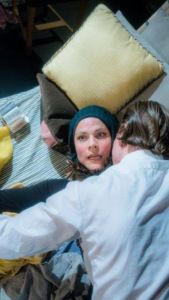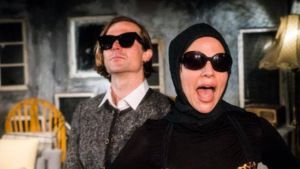Things to do
Performance Review: All hail a rendition as impressive as Jackie-O’s rise
This article is more than 7 years old.
★★★★★☆

Despite the leaning, this was very much a partnership of equals between Sue and Sira (all photos: Rickard S Söderström)
Disclosure time: I’ve never seen the classic 1977 documentary ‘Grey Gardens’ (or the 2009 TV movie starring Jessica Lange); I have a cat that will urinate on anything you leave on the ground (including me on one occasion); and by the end of a recent holiday with my 82-year-old mother, I had begun to feel like I was the hired help (two back rubs on the final day were the tipping point).
It was with such baggage that I arrived at Teatret Ved Sorte Hest last night to watch Why Not Theatre’s production of Sara Stridsberg’s ‘The Art of Falling’ (continuing until May 12), the first ever English-language version of a Swedish-written play based on the lives of Big and Little Edie, the reclusive aunt and cousin of Jackie Kennedy and residents of a cat piss-infested, rundown mansion in East Hampton.
Musical masterclass
This was a storming production aided by some first-rate acting, exemplary costume changes, well-judged sound effects and scenography, and engaging musical mash-ups, which included Cole Porter/opera, house music/a cuckoo clock, and several renderings of ‘Tea for Two’.
The American director Rhea Leman deserves special credit for her operatic pacing of the play. She wasn’t afraid to infuse the theatre with long silences to recover from and reflect on the cacophony of the two leads’ rambunctious dialogue.
If there is one small criticism, it is that the play really came into its own with music, and that retrospectively the first 20-25 minutes felt a little flat without much.
Simply Sue-pendous
Sue Hansen-Styles gave a nuanced performances as 78-year-old Big Edie – a role that would be easy to phone in for solely comical effect as the batty old woman who has lost her social graces.
Hansen-Styles, who it must be said has the most beautiful singing voice, expertly conveyed the movement and appearance of a woman approaching her 80s (bar the rather toned arms perhaps), while offering glimpses of the young woman who had graced high society as a glamorous, well-respected, younger matriarch.
It was a measured examination of the frailty of youth, and the approach rendered more menace to her unfeeling admissions to her daughter, which audibly stunned an audience that couldn’t laugh them off as the muddle of an old woman.
Stamp of approval
Ultimately, though, it was Sira Stampe as Little Edie who gave the play its emotional depth. It’s a telling quality of a well-worked script that it answers your questions at exactly the point you ask them: why had the daughter stayed with her mother all those years. And in the finalisation of her recalled affair with a Truman government official was the answer: not only was she the other child, she was the other woman, leaving her mother as her only hope of meaningful love.
Stampe, a little too young for the role in appearance, likewise resisted the temptation to gurn at her mother’s utterings for comic effect, instead opting for a disquieting penance. It rendered her emotional outburst at the end of the play all the more touching.
A permanently head-scarfed Stampe also performed an extraordinary number of onstage costume changes – expertly manipulating sashes and silks to alter her appearance. It must have taken an awful lot of rehearsing to do this without a mirror – and looking out into the audience as she changed, this was exactly the effect generated.
We need to talk about Kevin
While Stampe and especially Hansen-Styles are no strangers to fans of English-language theatre in Copenhagen, Australian actor Kevin Kiernan-Molloy is, but based on this performance it won’t be long until we see him again.
Kiernan-Molloy played six roles – and it is testament to how well he played them that I can effortlessly recall the exact order. Ask yourself whether you could do this with Brendan Fraser’s multiple parts in ‘Bedazzled’ or even Alec Guinness’s eight-character turn in ‘Kind Hearts and Coronets’.
He rendered six unforgettable performances, particularly shining as family members Bouvier, the odious journalist brother, and a strictly for laughs caricature of cousin/niece Jackie, whose meteoric rise couldn’t be more in contrast to Big and Little Edie’s fall.
That thought alone makes the story of Big and Little Edie one of the strangest of the last century. So don’t miss this chance to see it expertly portrayed on stage.












































